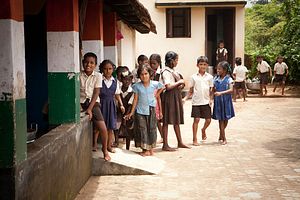The world’s leading financial institutions have projected both China and India as the strongest economies in Asia, with the potential to be among the top three economies of the world by end of the next decade. In fact, World Bank findings predict India will be the fastest growing major economy in the world. Some believed India has the potential of surpassing the Chinese economy by 2050, provided India is able to sustain its GDP growth at seven percent per annum.
China has witnessed remarkable growth, averaging GDP growth of over eight percent for the last three decades, a fear unparalleled in the history of any country. However, for the first time China is witnessing a slowdown in its economy, which is reflected in a fall in its GDP growth.
However, the true meaning of economic development is to be found only when people from all sections of society benefit and also when economic growth is able to achieve the UN Sustainable Development Goals by eliminating hunger, diseases, malnutrition, and illiteracy. Assessing the performance of a country solely based on a single metric like GDP does not give a true and accurate picture of a country’s progress. In this context, when one compares India’s progress with China’s on critical social indices, India is a laggard.
Three reports on different countries’ progress in eradicating poverty, diseases, and social development underscore this. The Global Burden of Disease 2015 report, 2016 Social Progress Index and the 2016 Global Hunger Index show that India lags far behind China in terms of human capital development.
The Lancet’s Global Burden of Disease study is a comprehensive global research program that assesses mortality and disability from major diseases, injuries, and risk factors. The latest edition ranked India 143rd out of 188 countries in meeting its health care goals. India’s performance lags behind smaller developing countries like Malaysia, Indonesia, Thailand, and Myanmar. China, on the other hand, was ranked 92nd. Among the BRICS Nations (Brazil, Russia, India, and China), India has made the least progress in health related goals.
The 2016 Global Hunger Index report, jointly published by the International Food Policy Research Institute (IFPRI), Concern Worldwide, and Welthungerhilfe (WHH) shows that although the level of hunger in the developing world has declined by 29 percent since 2000, it continues to remain distressingly high, with 795 million people still facing hunger, roughly one in four children affected by growth-stunting linked to chronic malnutrition, and 8 percent of children affected by wasting or acute malnutrition.
Although India has succeeded in lifting millions of people from poverty, it is ranked 97th out of 118 countries on the Global Hunger Index, with over 15 percent of its population undernourished. The findings show that India still has a long way to go. On the other hand, China is ranked 29th with 9 percent of its population undernourished. The ranking is done on the basis of a score between zero and 100, where zero represents no hunger and 100 represent an alarming and distressing situation; India scored a 28.5, while China scored 7.7. According to the index, “Scores between 20.0 and 34.9 points are considered serious.” At the current rate of progress, India may find it difficult to achieve the United Nations’ goal of ending hunger by 2030.
The Global Hunger Index also highlights that 38.7 percent Indian children below five years of age are stunted, with 15.1 percent suffering from wasting. This is a wake-up call for India — it needs to ensure efficient allocation of resources in the social sector by accelerating inclusive and sustainable economic growth if New Delhi hopes to meet the UN’s Sustainable Development Goals.
Finally, the Social Progressive Index relates to the progress made by countries in three areas: Basic Human Needs (nutrition, water and sanitation, shelter and personal safety), Foundations of Well Being (access to basic knowledge, health and wellness, ecosystem and sustainability) and Opportunity (personal rights, personal freedom and choice, access to advanced information, and tolerance and inclusion). In the 2016 edition of the index, India was ranked 98 out of 143 countries, in the “low” social progress tier.
China ranked higher than India (84th out of 143 countries, in the lower-middle category), but there is still great scope for China to make further improvements in their human capital if they want to join the likes of Finland, the U.K., Denmark, and Australia in the list of countries with “very high” social progress. Currently, Japan and South Korea the only Asian countries to reach the “high” social progress category. All in all, Japan, South Korea, and Singapore are the only three Asian countries that have mostly eliminated poverty and hunger and have made remarkable progress in human capital development.
There is an urgent need for the Indian government to invest heavily in education and public health care, as well as take effective steps to improve gender equality and address malnutrition and stunting, especially among young children. These are all necessary efforts if India aspires to outpace China in social development by the end of the next decade.
K.S. Venkatachalam is an independent columnist and political commentator. His articles have been featured in many leading newspapers.

































